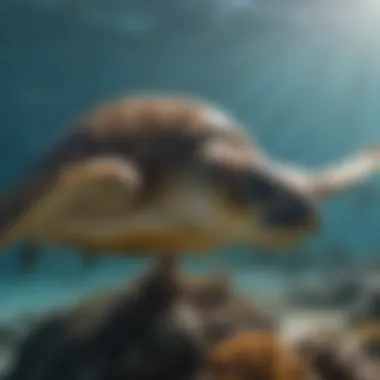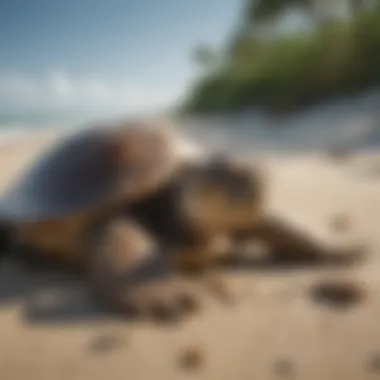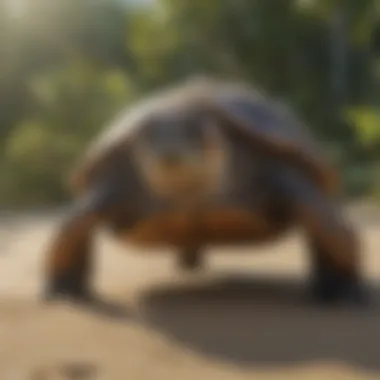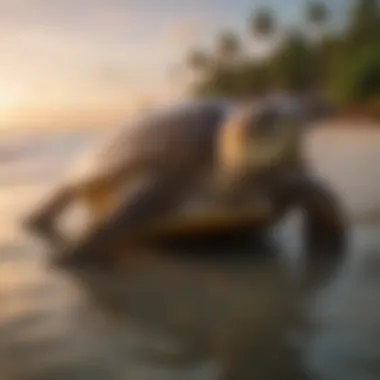Predators of Loggerhead Sea Turtles Explained


Nature Topic Overview
Loggerhead sea turtles are fascinating creatures that inhabit oceans worldwide. They are known for their large heads and powerful jaws. However, despite their size, they face numerous threats in their environment. Understanding their predators is crucial for their conservation. This article will explore the natural enemies of loggerhead sea turtles through different life stages.
Loggerhead sea turtles begin their lives in nests laid on sandy beaches. As hatchlings, they are particularly vulnerable to both terrestrial and marine predators. From birds to fish, a variety of animals prey on them. As they mature, their diet comprises mainly of jellyfish, which leads to new challenges. Large fish, sharks, and even other turtles may pose a threat to adult loggerheads.
Human activities compound these challenges. Pollution, habitat destruction, and climate change significantly impact their survival. This article will analyze these aspects to provide a better understanding of the ecological implications for loggerhead populations.
Fun Facts and Trivia
- Loggerhead sea turtles can weigh up to 400 pounds and measure over three feet in length.
- They are named for their large heads, which are adapted for crushing hard-shelled prey like crabs and conchs.
- The average lifespan of loggerhead turtles is estimated to be around 50 years.
Visuals and Interactive Elements
To engage young readers, visual aids like illustrations of loggerhead turtles and their predators will enhance learning. Interactive elements, such as matching games between turtles and their predators, could also be beneficial.
Wildlife Explorations
Loggerhead sea turtles share their ocean habitat with many other species. Notably:
- Sharks: Various shark species are known to attack juvenile and adult turtles. Great white sharks are among the most significant threats.
- Raccoons: These mammals can dig up and consume turtle eggs before they hatch.
- Seabirds: Birds like gulls often snatch hatchlings as they scamper towards the ocean.
Each of these animals plays a role in their respective ecosystems and impacts the population dynamics of loggerhead turtles.
Habitat Facts
Loggerhead turtles are commonly found in:
- Coastal areas of oceans, particularly in temperate and tropical waters.
- Nesting sites on Gulf of Mexico beaches and the shores of the southeastern United States.
Environmental Awareness
Conservation efforts are necessary to protect loggerhead turtles. Education and awareness can empower children and adults alike to contribute to their survival. Suggestions include:
- Educating about the recycling of plastics to reduce ocean pollution.
- Participating in beach clean-ups to keep nesting areas safe.
- Advocating for turtle protection laws at local and national levels.
"Every small effort counts when it comes to conservation. Protecting our wildlife is a shared responsibility."
Tips for Kids
Children can have an active role in conservation. Here are simple actions they can take:
- Reduce, reuse, and recycle materials.
- Write letters to local representatives urging for better protections for sea turtles.
- Observe nature respectfully, ensuring they do not disturb wildlife.
DIY Nature Activities
Engaging in hands-on nature activities can enhance understanding. Here are some ideas:
- Create a Turtle Habitat Diorama: Use recycled materials to make a model of a nesting site.
- Jellyfish Craft: Make jellyfish using paper plates and string, exploring what loggerhead turtles eat.
- Beach Scavenger Hunt: Organize a hunt to find objects that can harm sea turtles, like plastic bottles.
Suggestions for Outdoor Exploration
Encourage families to explore local waterways and learn about local wildlife. Observing natural habitats can deepen appreciation for the environment.
Intro to Loggerhead Sea Turtles
Loggerhead sea turtles are incredibly significant in marine ecosystems. Their presence is vital, impacting the health of ocean habitats and influencing various species. Understanding them helps to appreciate the delicate balance of marine life. This section will cover important aspects, including biological characteristics and their habitats. Recognizing these elements lays the groundwork for understanding their complex interactions with predators.
Biological Overview


Loggerhead sea turtles, known scientifically as Caretta caretta, are large reptiles characterized by their distinctive heart-shaped shells. Adults typically weigh between 200 to 400 pounds, with some individuals reaching lengths of up to four feet. Their shells, or carapaces, vary in color from reddish-brown to olive-green. This unique coloration helps them blend into their surroundings, providing some level of camouflage.
These turtles have powerful jaws, adapted to their diet, which mainly consists of crustaceans, jellyfish, and other marine invertebrates. With well-developed sensory organs, loggerheads navigate vast oceanic distances, employing both vision and olfaction. Their life cycle is complex and involves multiple stages, each with unique challenges and interactions with potential predators.
Habitat and Distribution
Loggerhead sea turtles inhabit a wide range of marine environments. They are frequently found in coastal regions, including bays and estuaries. Their distribution spans across the Atlantic, Pacific, and Indian Oceans. In the Atlantic, these turtles nest on beaches from Florida to South Carolina. In the Pacific, they prefer areas near Japan and the coasts of California and Mexico.
The habitats they occupy are critical for their survival. They depend on sandy beaches for nesting and shallow waters for feeding. The availability of such habitats is crucial, as it affects their reproduction and growth. Rivers and wetlands also play an important role in their life cycle, particularly for juvenile turtles.
Understanding the habitats and biological features of loggerhead sea turtles is essential. This knowledge provides insights into their vulnerabilities and the effects of predation on their populations.
Life Cycle of Loggerhead Sea Turtles
Understanding the life cycle of loggerhead sea turtles is crucial for comprehending how these creatures interact with their environment and what challenges they face. Loggerheads undergo several distinct stages, each presenting unique risks and vulnerabilities. By exploring the life cycle, we can identify key periods when predators threaten their survival and consider conservation strategies that can make a difference. The life cycle can be divided into four key stages: egg, hatchling, juvenile, and adult.
Egg Stage
The egg stage is the beginning of a loggerhead sea turtle's life. Female loggerheads lay their eggs on sandy beaches, usually at night. A single nest can contain between 100 to 200 eggs. It takes about 60 days for the eggs to incubate before they hatch. During this vulnerable period, the eggs are exposed to several natural predators. Animals such as raccoons and birds often dig up nests to eat the eggs. Additionally, environmental factors like temperature and humidity can influence the hatching success. Once hatchlings emerge, their journey to the ocean begins.
Hatchling Stage
The hatchling stage is critical as young turtles move from nests to the water. This journey is fraught with dangers. Predators like seagulls and crabs lie in wait. Survival rates for hatchlings are low, with estimates suggesting that only one in a thousand will reach adulthood. To increase their chances, hatchlings rely on instinct to race toward the ocean. Once in the water, they face new threats from marine predators, such as larger fish. This stage is characterized by the perilous transition from land to sea.
Juvenile Stage
At the juvenile stage, loggerheads become more self-sufficient but are still at risk. Juveniles often reside in protected areas, such as lagoons and estuaries, where they find abundant food and some shelter from larger predators. However, they still encounter risks from both natural predators and human activities. Sharks and larger fish may hunt juvenile loggerheads. The presence of pollutants and habitat degradation from humans can also impact their health and survival. It’s a formative period that shapes their growth towards adulthood.
Adult Stage
As loggerheads reach adulthood, they attain significant size, which offers some protection from predators. Adult loggerheads primarily face threats from humans rather than natural predators. Overfishing can lead to accidental capture in fishing gear, a serious risk for adult turtles. Still, larger marine predators, such as orcas, may occasionally attack adult loggerhead turtles. Understanding this stage is paramount for conservation efforts. Protecting adults is vital for maintaining the population and supporting the overall ecosystem.
Key Takeaway: The life cycle stages of loggerhead sea turtles highlight the critical points where conservation efforts can safeguard these creatures from various predatory threats.
Predators of Loggerhead Sea Turtles
Understanding the predators that threaten loggerhead sea turtles is crucial for a complete view of their survival challenges. Loggerhead sea turtles face a host of natural and human-induced predators throughout their life cycle. This section will explore various predatory threats, shedding light on how these factors contribute to the population dynamics of such an essential marine species.
Natural Predators
Predators in the Egg Stage
The egg stage is particularly vulnerable for loggerhead sea turtles. During this time, they are susceptible to several natural predators. Raccoons, foxes, and birds often prey on turtle nests. A key characteristic of predators in this stage is their opportunistic feeding habits. Given the soft shells of the eggs, these animals can access the nutrient-rich contents easily. Understanding this predation can inform beach conservation efforts, highlighting the need for protective measures around nesting sites.
A notable disadvantage to predators in the egg stage is that their presence often leads to reduced nest success. While natural selection plays a role in maintaining ecological balance, the loss of a significant number of eggs can deeply impact the overall loggerhead population.
Predators in the Hatchling Stage
Hatchling sea turtles face a variety of threats as they make their way from the nest to the ocean. During this journey, birds, crabs, and sharks are prominent threats. The hatchlings, despite their agility, are still quite small and vulnerable. A distinctive feature of predators in this stage is their ability to take advantage of the hatchling's instinctual behaviors. This predation contributes to a high mortality rate just after hatching.
For this article, the focus on hatchling predators is significant. The impacts of these natural threats can inform conservation strategies to ensure successful hatching rates and improve survival in early life stages.
Predators in the Juvenile Stage
As loggerhead turtles grow into their juvenile stage, they start facing different challenges. Larger fish and marine mammals become notable predators. A key aspect of juvenile predation is the shift in habitat; young turtles begin to inhabit different areas that expose them to new threats, such as open water. This increased exposure can lead to a higher chance of encounter with predators.
The unique feature of predators in this stage is their size and strength, which thus makes them significant threats compared to those faced earlier in life. Knowing these aspects assists researchers in highlighting specific juvenile challenges, leading to targeted conservation approaches.
Predators of Adult Loggerheads
Adult loggerhead turtles, often seen as less vulnerable, also have their share of predators. Orcas and the larger species of sharks can still pose significant threats. The interesting feature regarding these predators is their size and hunting tactics. While adults have size advantages over many predators, interactions can still result in fatal encounters.


Highlighting the role of adult predators is essential. It emphasizes that even at advanced life stages, loggerhead turtles play a significant part in the ocean's food web. The understanding of predation at this life stage helps quantify the total mortality impacts on species, framing adult turtles within a larger ecosystem context.
Human-Induced Predators
Fishing Hooks and Gear
Human activities lead to severe risks for loggerhead turtles. One major concern is the use of fishing hooks and gear. Strangely, many turtles mistake fishing bait for food, often leading them to become hooked. This aspect showcases the dual nature of human influence—where fishing can provide food for humans while simultaneously threatening marine life.
This practicality is crucial for discussions about sustainable fishing practices and its direct consequence on turtle populations. Addressing this issue is vital for preserving loggerhead turtles and ensuring their numbers can recover in the wild.
Boat Collisions
Another human-induced threat is from boat collisions. Loggerhead turtles often share waters with various vessels, leading to unfortunate interactions. Collisions can cause severe injuries or even death. Notably, the chaotic nature of marine traffic increases the chances of such accidents significantly.
Focusing on the aspect of boat collisions helps communicate the importance of awareness and regulations regarding boating in turtle habitats. Educating boaters may reduce the risks for these sea turtles in specific areas.
Pollution Effects
Pollution plays a vast role as a predator in the broader sense. Marine debris, especially plastics, pose significant threats to loggerhead turtles. Sea turtles may ingest plastic or become entangled in marine litter, leading to fatal consequences. This aspect of pollution stands out as a unique threat that combines both direct and indirect effects on loggerhead turtle health.
Understanding pollution helps paint the bigger picture of how human actions impact marine ecosystems. Addressing pollution on a global scale can drastically improve survival rates across loggerhead turtle populations.
It is vital to recognize the interconnectedness of natural and human-induced threats to loggerhead sea turtles. Only through careful study and targeted conservation strategies can we aim for their protection in a rapidly changing world.
Ecological Impact of Predation
The ecological impact of predation on loggerhead sea turtles is a complex and significant theme within the broader discussion of their survival. As one of the prominent species in marine ecosystems, loggerhead turtles play a vital role in maintaining a balance within their habitats. Understanding the effects of predation on their population dynamics assists in forming conservation strategies aimed at preserving this critical species.
Role of Predation in Ecosystems
Predation serves as a natural regulatory mechanism in ecosystems. While many people might view predators as threats, their presence often indicates a healthy ecosystem. For loggerhead turtles, natural predators impact their life stages differently. For instance:
- Egg and Hatchling Stages: In these initial phases, loggerhead eggs and hatchlings are highly susceptible to a variety of predators. Animals such as raccoons, birds, and crabs can significantly reduce the number of hatchlings that make it to the sea.
- Juvenile and Adult Stages: As turtles mature, they face threats from larger aquatic animals, like sharks and orcas, that hunt for food. The balance of these predator-prey relationships affects population numbers and genetic diversity.
The role of predation helps control loggerhead populations, ensuring that the species does not outstrip food resources or overcrowd their habitats. This balance is critical for the overall health of marine environments, which rely on the presence of various species to function effectively.
Predator-Prey Dynamics
The dynamics between predators and loggerhead turtles are influenced by numerous factors, including environmental changes and human activities. Various species find themselves at different levels on the food chain, affecting how predator-prey relationships evolve.
- Natural Adaptations: Loggerhead turtles have developed natural adaptations that help them evade predation. Their hard shells provide some protection against would-be predators, especially during the juvenile stage. Yet, these defensive strategies can only go so far.
- Impact of Human Activity: Human interference, such as overfishing and habitat destruction, can upset these long-standing relationships. For example, if shark populations are depleted due to fishing, the effect on loggerhead populations becomes complex. An increase in juvenile turtles could lead to overpopulation and competition for food resources.
Understanding these dynamics is essential for effective conservation efforts. When we grasp how predation works in the natural world, it becomes more apparent what we must do to help loggerhead turtles thrive in ever-changing environments.
"Predators are not just threats but are essential for maintaining the balance in ecosystems that support loggerhead sea turtles."
Conservation Efforts and Strategies
Conservation efforts play a crucial role in the survival of loggerhead sea turtles. These efforts aim to protect not only the turtles themselves but also their habitats and nesting sites. Since loggerhead turtles face numerous threats, including predation and human activity, effective strategies are essential for their continued existence.
Both local and global initiatives contribute to the preservation of these marine creatures. Protecting nesting sites is one of the most effective methods. This involves monitoring beaches where loggerheads lay their eggs and ensuring that disturbances from human activity are minimized. A safer nesting environment helps increase the survival rates of hatchlings.
Furthermore, establishing laws and regulations is critical in providing a framework for protection. These laws help reduce harmful practices, such as illegal poaching or habitat destruction. Enforcing these regulations ensures that loggerhead sea turtles are safeguarded against threats posed by humans.
Another promising strategy is increasing engagement and awareness among the public. Through education about the importance of loggerhead turtles to marine ecosystems, communities can become advocates for conservation. Greater awareness leads to increased participation in initiatives aimed at protecting these creatures and their habitats.
Effective conservation requires a collective effort. Each small action contributes to the larger goal of ensuring the future of loggerhead sea turtles.
Protecting Nesting Sites


The protection of nesting sites is vital for the survival of loggerhead sea turtles. Nesting sites are areas where female loggerheads lay their eggs, typically on sandy beaches. If these sites are disturbed, it can lead to decreased hatchling survival rates. Protecting nesting areas ensures that these turtles can reproduce safely.
Local organizations often monitor nesting sites to identify when loggerhead turtles are laying eggs. Here are some measures implemented to protect these sites:
- Beach Clean-Ups: Keeping nesting beaches free from trash helps reduce hazards that could harm loggerhead turtles and their eggs.
- Signage and Barriers: Installing signs and temporary barriers can prevent visitors from disturbing nesting areas.
- Monitoring Programs: Volunteer programs can involve the community in monitoring nests and documenting hatchling movements.
These actions are crucial for increasing the number of healthy hatchlings that make it to the water.
Legislation and Protection Laws
Legislation surrounding loggerhead sea turtles provides essential protection through laws that regulate human behavior. Many nations have enacted laws that prohibit the harming or harassment of loggerhead turtles and their habitats. Some benefits of these laws include:
- Banning Poaching: Strong laws reduce illegal capture and trade of loggerhead turtles.
- Regulating Fishing Practices: Laws can limit fishing methods that unintentionally capture turtles, such as certain nets.
- Designating Protected Areas: Specific areas can be established as wildlife reserves, ensuring loggerheads have safe zones for nesting and feeding.
Overall, legislation is a powerful tool that, when properly enforced, protects loggerheads from various threats.
Engagement and Awareness Campaigns
Engaging various audiences is a significant aspect of loggerhead sea turtle conservation. Educational campaigns can effectively raise awareness about the challenges these turtles face. Here are some strategies that work well:
- School Programs: Schools can incorporate curriculum elements about marine biology and conservation. This instills a sense of responsibility in children from a young age.
- Community Workshops: Local workshops can teach residents about responsible beach behavior and the impact of litter on turtle nests.
- Social Media Campaigns: Platforms like Facebook and Reddit allow organizations to reach a broader audience. Engaging content can create a strong community around turtle protection.
By involving the community, engagement and awareness campaigns can inspire action, leading to better conservation outcomes. These strategies not only protect loggerheads but also promote broader environmental awareness.
Future Research Directions
Research concerning loggerhead sea turtles is crucial for a better understanding of their lives and the challenges they face. By focusing on future research directions, we can identify gaps in current knowledge, which can help in developing effective conservation strategies. As threats evolve, so too must our research methods and approaches. The importance of investing in future studies cannot be overstated.
Innovative Tracking Methods
Advancements in tracking methods provide new possibilities for studying loggerhead sea turtles. Traditional methods, like tagging, have limits. New technologies, such as satellite telemetry and GPS, allow researchers to follow these turtles more closely than ever before. For instance, satellite trackers can provide data on migration patterns, feeding grounds, and even their interactions with predators. This information is vital to understand their behaviors and identify crucial habitats that require protection.
"Understanding the movements of loggerheads can lead to better conservation efforts and policies."
In addition, innovative methods, like bio-logging devices, can track acceleration and depth. By gathering this data, researchers can understand how loggerheads behave while swimming or foraging. Such insights are key in recognizing the impact of various predators in different stages of their lives. If a loggerhead turtle frequently changes its route, it may be a response to encountering predators or environmental factors. This is a valuable lesson for conservationists aiming to mitigate these challenges.
Behavioral Studies of Predation
Another important area is the behavioral studies focusing on loggerhead sea turtles and their predators. By observing and analyzing interactions between loggerheads and their natural predators, researchers can uncover patterns that indicate the turtles’ survival strategies. For example, understanding how adult loggerheads evade sharks or how hatchlings navigate the dangers of the shore can provide insight that is critical for species survival.
Such studies involve direct observation, as well as artificial settings where scientists can simulate predator presence. Researchers can assess how factors such as light, noise, and environmental cues influence the turtles' decisions. This research adds depth to our comprehension of predation in their life stages.
Moreover, behavioral studies are not only about understanding the turtles themselves. They also involve examining how changes in ocean ecosystems, driven by human activity, alter predator behavior. This information helps create informed management plans that can improve loggerhead populations in the long term.
End
In this article, we have examined the complex landscape of threats faced by loggerhead sea turtles. Understanding the diverse predators that affect them is crucial for several reasons. Firstly, recognizing both natural and human-induced predators allows for more informed conservation strategies. With better knowledge of how these turtles are targeted, we can develop tailored actions to protect them effectively.
The real-life consequences of predation impact loggerhead populations at various life stages. Each stage, from eggs to adults, has its unique set of challenges and predators. This insight into the survival threats faced by loggerhead sea turtles not only emphasizes the necessity for conservation efforts but also highlights the interconnectedness of marine ecosystems.
Moreover, acknowledging how human activity exacerbates these threats reinforces the need for responsible behavior towards nature. The ocean is a shared space, and our actions play a role in the well-being of all its inhabitants.
"Understanding the predators of loggerhead sea turtles' is fundamental to ensuring their survival and maintaining the balance of marine life."
Summary of Key Points
- Loggerhead sea turtles face various predators during their life stages, including natural and human-induced threats.
- Their eggs are vulnerable to predators like birds and crabs.
- Hatchlings have high mortality rates due to predation and environmental factors.
- Juvenile and adult loggerheads encounter marine threats, including larger fish and human activities.
- Conservation strategies should address both natural and anthropogenic influences on loggerhead populations.
Call to Action for Conservation
It is imperative for individuals and organizations to become advocates for loggerhead sea turtles. Here are actionable steps you can take:
- Participate in local beach clean-ups to reduce pollution and debris that harm turtles.
- Support legislation aimed at protecting marine habitats and preventing bycatch in fishing.
- Educate others about the importance of protecting loggerhead sea turtles and their ecosystems.
- Donate to organizations dedicated to marine conservation or volunteer for turtle preservation programs.
By taking these actions, everyone can contribute to the survival of loggerhead sea turtles and help secure their future.
Understanding the pressures they face is the first step. With collective efforts, we can create a safer environment for these remarkable creatures.







